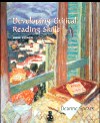An Overview of the Text and the Reading Process
Improving Your Vocabulary
Punctuation
On the Web
PART 1 READING FOR UNDERSTANDING: PRACTICE IN BASIC COMPREHENSION SKILLS
CHAPTER 1 READING FOR THE MAIN IDEA AND AUTHOR’S PURPOSE
The Main Idea of the Paragraph
Main Idea and Controlling Idea
The Placement of the Main Idea
Implied Main Ideas
Levels of Support
The Author’s Purpose and Modes of Discourse
Exercises
Selection 1: E. D. Hirsch, Jr., Cultural Literacy: What Every American Needs to Know
Selection 2: Eric Schlosser, Fast Food Nation: The Dark Side of the All-American Meal
Selection 3: Jacques Leslie, “Running Dry,” Harper’s
Practice Essay: Bill Buford, “Among the Thugs”
On the Web
CHAPTER 2 READING BETWEEN THE LINES: MAKING ACCURATE INFERENCES
Facts and Inferences
Problems with Inferences
Explaining Sample Inferences
Using Evidence to Make Inferences
Making Open-Ended Inferences
Selection 1: Robert Lacey and Danny Danzinger, The Year 1000
Selection 2: Jan Yoors, The Gypsies
Selection 3: Diane Ackerman, The Natural History of the Senses
Practice Essay: Kurt Wiesenfeld, “Making the Grade”
On the Web
PART 2 DISCOVERING MEANING: THE IMPORTANCE OF FORM
CHAPTER 3 FOUR METHODS OF PARAGRAPH DEVELOPMENT
Modes of Discourse and Methods of Development Compared
Methods of Paragraph Development
Conclusion: Methods of Development and Patterns of Thought
Exercises
Selection 1: Jeremy Iggers, ”Innocence Lost,” Utne Reader
Selection 2: Daniel Duane, Caught Inside: A Surfer’s Year on the California Coast
Selection 3: Suketu Mehta, “Mumbai: A Lover’s Embrace,” Granta
Practice Essay: Rose Del Castillo Guilbault, “Book of Dreams: The Sears Roebuck Catalog”
At the Movies
CHAPTER 4 FOUR MORE METHODS OF PARAGRAPH DEVELOPMENT
Methods of Paragraph Development: The Second Group
Combination of Methods
Conclusion: Methods of Development and Patterns of Thought
Exercises
Selection 1: Desmond Morris, Manwatching: A Field Guide to Human Behaviour
Selection 2: Mark Twain, Life on the Mississippi
Selection 3: Mark Schapiro, “Muddy Waters”
Practice Essay: Pico Iyer, “In Praise of the Humble Comma”
On the Web
CHAPTER 5 PATTERNS OF PARAGRAPH ORGANIZATION
Patterns of Organization Defined
Coherence in Paragraphs
Transitions
Exercises
Selection 1: Ivan Doig, This House of Sky: Landscape of a Western Mind
Selection 2: Ted Conover, “Guarding Sing Sing,” The New Yorker
Selection 3: David Quammers, “Planet of Weeds,” Harper’s
Practice Essay Castle Freeman, Jr., “Surviving Deer Season: A Lesson in Ambiguity”
On the Web
PART 3 DISCOVERING MEANING: THE IMPORTANCE OF LANGUAGE
CHAPTER 6 LANGUAGE AND ITS EFFECTS ON THE READER
Denotation and Connotation
Figurative Language
Language Misused and Abused
Exercises
Selection 1: Bruce McCall, Thin Ice: Coming of Age in Canada
Selection 2: Ella Leffland, Rumors of Peace (used in 2nd & 3rd eds.)
Selection 3: Margaret Atwood, “The View from the Backyard”
Practice Essay: Virginia Woolf, “The Death of the Moth”
In the Bookstore
CHAPTER 7 TONE, POINT OF VIEW, AND ALLUSION
Point of View
An Overview of Tone
Tone Continued: More Difficult Varieties
Allusion
Special Effects
Understatement
Hyperbole
Alliteration
Repetition for Effect
Unusual Sentence Structure
Exercises
Selection 1: Ian Frazier, On the Rez
Answers
Selection 2: Sissela Bok, Secrets: On the Ethics of Concealment and Revelation
Selection 3: Gerald Durrell, “The Life and Death of Cholmondeley”
On the Web
PART 4 READING CRITICALLY
CHAPTER 8 ELEMENTS OF CRITICAL READING
Critical Reading Defined
The Reader’s Responsibilities
Developing a Worldview
The Structure of Arguments
The Test of a Good Argument
Taking Arguments Apart
Exercises: Evaluating Editorials
Selection 1: Arthur Levine, “College—More Than Serving Time,” The Wall Street Journal
Selection 2: Amitai Etzioni, “ACLU Favors Porn Over Parents,” The Wall Street Journal
Selection 3: Marjorie Hardy, “Very Young Guns,” The New York Times
CHAPTER 9 EVALUATING ARGUMENTS: PROBLEMS IN CRITICAL READING
Inductive and Deductive Reasoning
Problems with Inductive Reasoning
Problems with Deductive Reasoning
Emotional Appeals in Arguments
Logical Fallacies: Part I
Logical Fallacies: Part 2
Summary of Emotional Appeals and Logical Fallacies
Bias and Other Deceptive Techniques
Exercise in Evaluating Editorials
Selection 1: Bob Herbert, “The Other America,” The New York Times
Selection 2: Andrew Bernstein, “Conservation Is Retrograde, Immoral, and Un-American,” San Francisco Chronicle
Selection 3: Tony Judt, “New York Diarist: Burst,” The New Republic
Selection 4: Lance Morrow, “The Case for Rage and Retribution,” Time
Selection 5: Frank Viviano, “The High Price of Disengagement,” San Francisco Chronicle
CHAPTER 10 CRITICAL READING AND THE WORLD WIDE WEB
Reading Online versus Reading Print
Search Engines
Websites for Critical Reading Skills
Websites for On-Line Reading
Exercise 1: Evaluating Two Online Articles
Exercise 2: Evaluating Three Political Parties’ Websites
Exercise 3: Appraising Websites on a Health or an Environmental Issue
Exercise 4: Researching a Controversial Issue
Exercise 5: Analyzing Richard Nixon’s “Checkers” Speech
PART 5 READING ESSAYS AND ARTICLES
Introduction to Reading Essays
Analyzing Essays: Questions to Ask
Practice Essay Stephen Jay Gould, “Sex, Drugs, Disasters, and the Extinction of the Dinosaurs”
Analysis of Practice Essay
Writing Summaries
Sample Summary
Fourteen Essays and Articles for Further Practice
Selection 1: Gish Jen, “An Ethnic Trump”
Selection 2: Ryszard Kapuscinski, “The Truck: Hitching through Hell”
Selection 3: Andrei Codrescu, “Faux Chicken & Phony Furniture: Notes of an Alien Son”
Selection 4: Calvin Trillin, “It’s Just Too Late”
Selection 5: Diane Ackerman, “Colors”
Selection 6: William Lutz, “Abstracting Our Way into Doublespeak”
Selection 7: Malcolm Gladwell, “The Law of the Few”
Selection 8: Ian Frazier, “SuAnne Big Crow”
Selection 9: Samuel H. Scudder, “In the Laboratory with Agassiz”
Selection 10: Stephen L. Carter, “The Insufficiency of Honesty”
Selection 11: Jane Kuenz, “Shiny Happy People Working at the Rat”
Selection 12: Michael Wilbon, “History in Black and White”
Selection 13: Evan Imber-Black, “Talk Show Telling Versus Authentic Telling: The Effects of the Popular Media on Secrecy and Openness”
Selection 14: Loren Eiseley, “The Brown Wasps”
PART 6 READING SHORT STORIES
Selection 1: Leo Tolstoy, “How Much Land Does a Man Need?”
Selection 2: Steven Millhauser, “The Knife Thrower”
Selection 3: Jamaica Kincaid, “Girl”
Selection 4: Katherine Anne Porter, “The Jilting of Granny Weatherall”
|



 2003 McGraw-Hill Higher Education
2003 McGraw-Hill Higher Education

 2003 McGraw-Hill Higher Education
2003 McGraw-Hill Higher Education